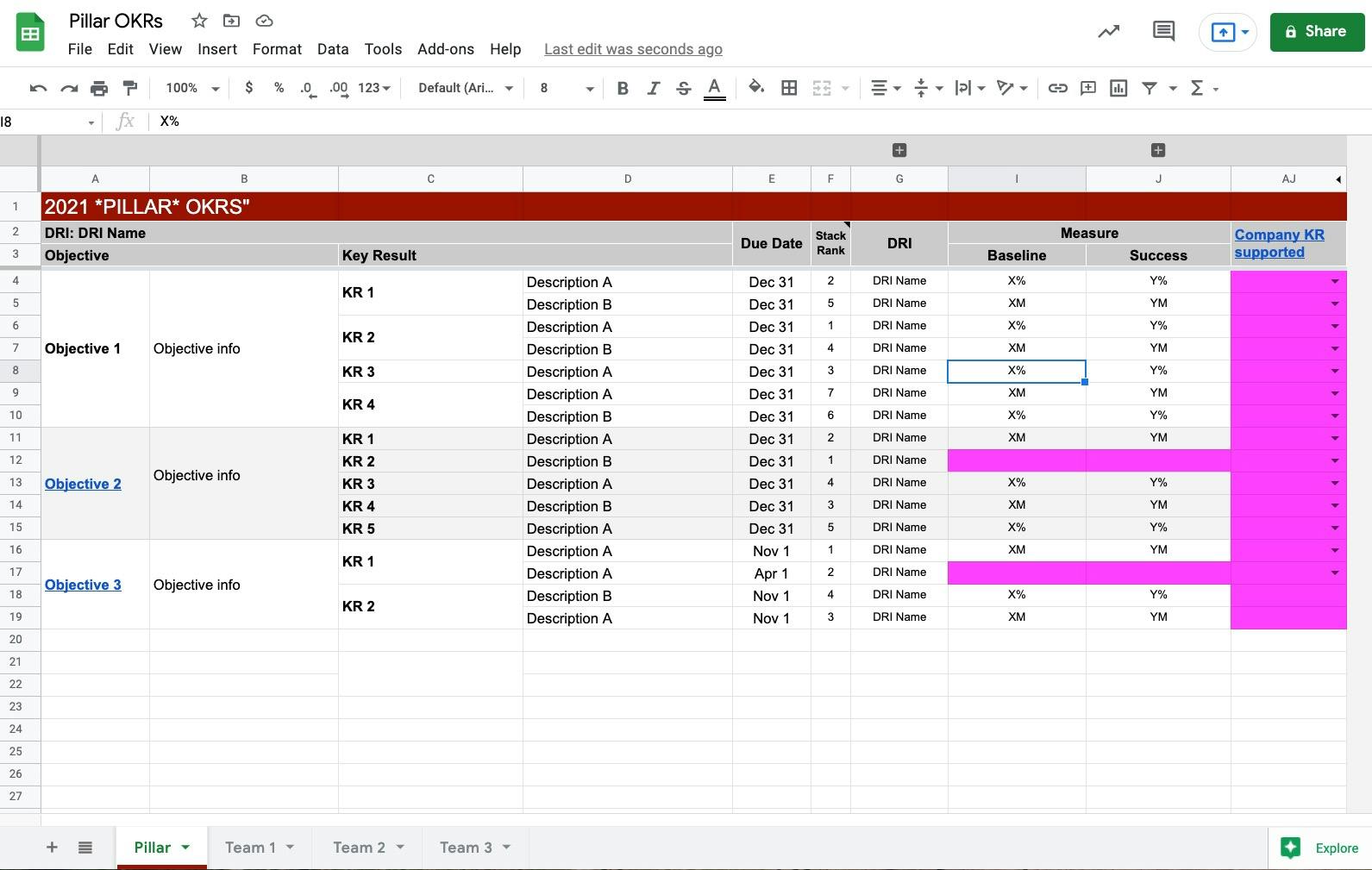Skip to content


Team leads wanting to more easily see progress against goalsEmployees wanting to more easily find and navigate OKRs of other teamsEmployees wanting to better understand how their work ladders up to company goalsLeaders feeling like they copy and paste the same data in multiple docsDifficulty in pulling reports or specific dataInstability and inconsistency in our toolsGenerally a bad user experience
Visibility: To increase transparency and visibility of OKRs, companies usually create a PowerPoint deck, Google Doc, or some other artifact that gives the entire company a high-level view of the company’s OKRs. We take this one step further and make regular updates to our progress in achieving our company strategy and goals. These updates can include learnings on what’s working and not working so our team leads and Pillar DRIs can make adjustments as necessary.Agility: Traditionally, companies have QBRs and business updates every month or quarter to provide a historical view of what happened in the business. There may be new priorities that pop up, but generally speaking, the priorities are set for the quarter/year and teams work on these priorities. At Pinterest, we optimize for agility by taking new information learned from product launches and other data points to adjust our resource allocation and product roadmaps. This can happen every sprint as we gather new information.Forums for decision-making: Most companies make their strategic decisions during their quarterly or annual planning cycles. The remainder of the time is spent in execution mode. Pinterest’s operating cadence allows for these big strategic decisions to take place outside of the planning cycle. Pinterest is proactive in scheduling these forums for discussing and making strategic decisions versus reacting to events that happen in our business. This ongoing cadence of meetings gives teams space to make decisions and communicate their rationale to the rest of the company.
How can I easily see my team’s progress against goals?How can I easily find my team’s (or other team’s) OKRs?How can I easily see how my work ladders up to our company goals (and vice versa)?We copy and paste the same data in multiple docs; how might we streamline our updates?How might we make it easier to pull reports/views specific to my needs?How might we leverage existing data to make our check-ins more efficient?How might we create stability between the different teams’ OKR views that doesn’t rely on fragile formulas?How do we ensure a consistent user experience for logging OKR updates at different levels of the organization?
How Naveen Gavini transformed OKRs at Pinterest
Pages

 How Naveen Gavini transformed OKRs at Pinterest
How Naveen Gavini transformed OKRs at Pinterest
How to avoid silos when setting goals at scale
We use Objectives and Key Results (OKR) to track goals at Pinterest like many other fast-moving and innovative companies. It’s been a great way to set intentions, align our teams, and achieve amazing feats.
As we scaled though, we found that our collection of sheets and docs were becoming more like a bowl of spaghetti rather than the clear Pyramid structure that we had originally sketched out. Running OKRs with transparency, efficiency, and stability were feeling increasingly out of reach with our growth, so I took on a personal OKR as the Head of Product to attempt to better organize our workflows. After reflecting with my EPD (Engineering, Product, and Design) leadership team last year, we asked: Is there a better way to plan and track goals?
We overhauled our existing patchwork of OKR trackers to build a single Pyramid OKR Tracker. Here’s how and why we did it with Coda.
This doc includes Pinterest’s . Feel free to create a copy and customize it for your own team.
Copy template
History: Our Journey into OKRS
Having had the good fortune of being with Pinterest as we scaled from less than 15 employees when I joined in 2012 to more than 2,000 staff now, I’ve been able to have a first hand look at how our approach to goal-setting has evolved through our years of scaling.
When we were around 50 employees, we had just one set of company goals anchored to major milestones and deliverables —e.g., launch our mobile app, migrate to a new API, ship X feature by Y date. Since this list was limited, everyone generally knew what was happening and when.
As we scaled and grew various functions, we saw our list of commitments and goals starting to grow and branch out. We also saw a need for teams and individuals wanting to set their own goals that connected to our top-line goals. Like many organizations, we adopted OKRs as a process to help align our company objectives with our team’s results as we scaled.
If you’re not familiar, OKRs (Objectives & Key Results) were originally created by Andy Grove to track goals at Intel. John Doerr, a then-salesmen at Intel, carried the to his new job at venture capital firm Kleiner Perkins. He then introduced OKRs to Google — one of Kleiner Perkin’s investments — who, according to Google co-founder Larry Page, used them to propel 10x growth on multiple occasions. If you want to learn more about how Google uses OKRs, I recommended watching this .
Teams started brainstorming their Key Results, strategy docs were shared around, and before we knew it, we had an excited organization rallying around the OKR framework. Things came along nicely: teams were better connecting to our mission and we felt like the right structure was finally coming into place.
We doubled, then tripled the size our team in just a matter of a few years, pushed well into international markets outside of the US, and were finding unique ways to monetize and build revenue streams as we evolved to become a revenue-generating business. Through this journey, OKRs helped clarify the important objectives, kept teams aligned, and created an accountability structure.
When we first adopted OKRs, we adopted the process, not a tool. So when it came time to build and track in practice, we reached for what was around: spreadsheets and documents.
Our problem: Scaling OKRs
Although there are many resources out there that provide guidance on how to set individual OKRs or team-level OKRs, there are few that describe how to scale these into a connected system. As we grew and scaled, the size of what we built ballooned, and as many employees pointed out, things were becoming a mess.
We now had hundreds of Docs, 10+ silo’ed top-level Google Sheets, and some wild sync’ed data via Google Apps Script along with fragile formulas that could be overwritten. If you were a new employee, it was hard to know where to look to see your goals. Beyond that, each team was tracking things slightly differently, causing the cascade down and roll up of goals to become muddled.
If this sounds familiar, it’s because it is. I’ve shared our setup with others in my position and almost every one of us has sheets that ended up looking something like this 👇


Company-wide OKRs Google Sheet. Just one.


Pillar-level (one level below company) OKRs Google Sheet. Many of these.
Given the size of our company, a spreadsheet of OKRs wasn’t sufficient; we needed documentation about our OKR process, which was kept in yet another place. With siloed information and inconsistent user experiences, we saw decreased comprehension of goals, inconsistent accountability structures, and we were having the wrong discussions. Rather than OKRs being a tool to help us orient towards the future, understanding them turned into an anchor that caused us to litigate the past.
As we grew, we were running into these requests and complaints with using our duct taped doc and sheet setup:
How Pinterest structures OKRs
Before I dive into how we worked with Coda to develop a new , it’s worth discussing a few unique features of our OKR process and workflow.
From a planning and goals perspective, our company is organized by Company → Pillars → Teams → Individuals.
Name
Definition
Examples
Name
Definition
Examples
Company
Annual company plan
Top Line Output Metrics: Engagement, Revenue, Employee NPS, Developer Velocity, etc
Pillar
Strategic focus area
Input & output metrics that ladder into our company objectives and key results
Team
A group of 7-12 people focused on a pillar’s objective
Input metrics or tactical projects
Individual
An individuals half-yearly goals
Projects to contribute to or complete
There are no rows in this table
Our OKRs are tightly aligned with our company planning and operating cadence. For instance, our Company strategy and roadmap inform how Pillar DRIs (Directly Responsible Individual) create their OKRs. The Pillar objectives roll-up into our Company-level OKRs.
Planning
Towards the end of each year, we begin our planning process to set ourselves up for the next year. While our mission has remained consistent over the years; our strategy, objectives, and key results evolve.
The intent of our Pyramid structure is to strengthen the connection between our mission and longer-term strategy to individuals who are on the ground working on critical projects.


Each planning cycle, we generally begin with an update to our longer term vision and strategy (18-24 month timeframe). This is usually done by the executive team with input from key leaders across the company. We use our company strategy to define Pillars, or strategic areas of focus.
We then assign a Pillar DRI (Directly Responsible Individual) for each Pillar, someone who is accountable for the success of that area. The Pillar DRI works closely with their XFN partners and teams to craft a Pillar strategy and Objectives that ladder into the longer-term company strategy and vision.
We then share the strategy and objectives for each Pillar with responsible teams and enable them to plan Team-level OKRs and roadmaps. Team goals are usually set with a time horizon of either a quarter, a half or a year. Once team planning is completed we can take the output from team plans and quantify Pillar Key Results for each Pillar Objective.
Once we have complete Pillar OKRs, they are shared back with the Pillar DRIs and executive team. We conduct a series of deeper reviews and trade off discussions to round out planning. When we complete our planning process, we have an updated longer-term vision and strategy, and an annual plan that consists of both cascading OKRs as well as a roadmap of key launches for the year.
This ”W” sequencing pattern of planning leads to an output of cascading OKRS from Company → Pillar → Team → Individual.


Operating Cadence
We write and track our OKRs in line with our operating cadence: strategic direction when needed (more than a year), quarterly progress on long-term objectives, monthly status updates on execution and roadmap, and weekly monitoring on critical business metrics.


Overview of our operating cadence
Once we’ve developed our strategy and OKRs, we put these OKRs into action through our operating cadence. A few things separate Pinterest’s OKR process and operating cadence from other companies I’ve worked at:
Solution: Pyramid OKR Tracker
As we imagined how we might scale OKRs, we worked closely with Coda Solutions to design a new system for increasing transparency, ramping up efficiency, and laying down stability:
Goal
Description
Questions to answer
Goal
Description
Questions to answer
Transparency from the top objectives to the bottom key results so that leadership to individuals are aligned.
As more teams and people get added to our org, ensuring key individuals have the ability to easily understand and action OKRs across the business.
Efficiency so that the team can focus on doing the work and not on the tracking of the work.
Scaling the team means that as complexity grows, the time to manage the process doesn’t.
Stability of a foundation that we can grow and build on.
Creating the right structure from the tops down with the tooling to support.
There are no rows in this table


Interested in deploying an OKR system at your company?
I’d suggest starting with copying this . For smaller companies and teams, this might work right out of the box. For scaling companies, the principles and structure here could likely be adapted and applied to how you set OKRs.
Migrating to a new OKR system often isn’t easy: there are tweaks to how your company operates, data to migrate, and individuals to be trained on a new way of working. We had a ton of fun partnering directly with the Coda Solutions team to help co-design and roll out this Pyramid OKR Tracker.
Want to print your doc?
This is not the way.
This is not the way.

Try clicking the ⋯ next to your doc name or using a keyboard shortcut (
CtrlP
) instead.